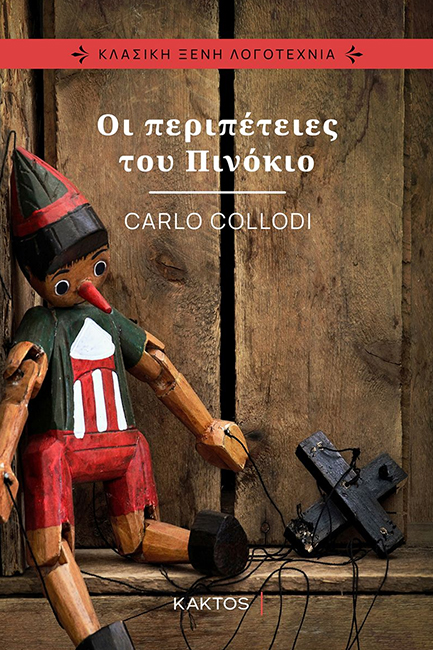
CARLO COLLODI
The Adventures of Pinocchio
translated. Evy Herokosta, published by Kaktos
How many of us know that “Pinocchio” for Italians is not a lying puppet with a growing nose, but an “old man” with a kind – sometimes kind – heart, who “begins to grow up by the end of the story”? We know the hero almost exclusively thanks to Disney. We ignore the fact that the book of the Florentine “satirist journalist” Collodi (pseudonym Carlo Lorenzini, 1826-1890), written in the 19th century, is considered by Italian scholars “one of the greatest literary works in the world.” Moreover, it is the most widely translated Italian book, although Collodi died before he suspected its future worldwide success. These and other impressive and valuable things we get from a recent annotated edition of the classic work. Lying is not the main feature of the classic Pinocchio, although the hero of Collodi does not lie from time to time, and the author “punishes him by making him grow a nose.” The book published by Kaktos is based on the English translation of the work, published in autumn 2021 by Penguin Random House. However, the Italian original was also taken into account.
The masterpiece of Carlo Collodi is in many ways reminiscent of The Amazing Journey of Nils Holgersson by Selma Lagerlöf.
Some confusion is caused by the translation-related references in the notes included in the Penguin edition when they explain, for example. because “ultra-Italian Mamma mia!” it becomes “My God”, of course, in English, where there is obviously no equivalent expression, but not in Greek, where everything, as we know, is different, that is, much closer to Italian. The translation, informative introduction (hence the citations above), and rich liner notes of the Penguin edition are signed by John Hooper and Anna Krachina.
Both Penguin and the Greek publisher recommend the book as a “classic” rather than a children’s book. Of course, there is no reason why children should not be introduced to this wonderful literature in its full version, and not just the simplified Disney versions. It is important that they slowly read some “adult” books as they get older. Only in this way is a work of classical culture brought to perfection, only in this way is it truly given the opportunity to resist time.

Pinocchio was published by Collodi in serials beginning in 1881 in a children’s magazine and published as a book in 1883. A popular, post-Risorgimento Italy, suffering from poverty while trying to regroup and move forward based on values like honesty. and education, the efforts made in those decades to provide a basic education for children from the poor, habits, contrasts and typical human characters, as well as unjust institutions, provide material for a dramatic legend that a socio-politically sensitive author composes with a critical and disturbing spirit . Pinocchio’s wanderings are long, much longer than the simplified versions that we have come to know through cinema. Thus, the side of patriotism also turns out to be strong, and elements of magic, miracle, fairy tale make reading easy to understand and bewitching. It is in many ways reminiscent of Selma Lagerlöf’s The Amazing Journey of Niels Holgersson, although the character of Pinocchio and his journey to psychological maturity remains central to the Italian narrative, while nostalgia and magic prevail in Swedish. It is no coincidence that in the title “Kolodi” the main characters are “adventures” – the suffering of an unfortunate puppet, and in the Swedish fairy tale the impression of the magic of a wondrous journey on goose wings wins.
Pinocchio keeps falling and getting dirty, literally and figuratively. Under his responsibility, he repeatedly endangers his life and the lives of his loved ones. He, like any child, is selfish and narcissistic, and as long as he is attached to this childishness, he retains the status of a wooden puppet, that is, he remains trapped. When he grows up, which becomes possible, including thanks to unconditional parental love and practical affection, he becomes a real boy. This is a gentle, sensitive, but surprisingly weak character, and it is not at all difficult to think that, based on stereotypes, he is just very Italian, capable of outbursts of love, honesty and courage, but also of a lot of disastrous frivolity.
Source: Kathimerini
Ashley Bailey is a talented author and journalist known for her writing on trending topics. Currently working at 247 news reel, she brings readers fresh perspectives on current issues. With her well-researched and thought-provoking articles, she captures the zeitgeist and stays ahead of the latest trends. Ashley’s writing is a must-read for anyone interested in staying up-to-date with the latest developments.